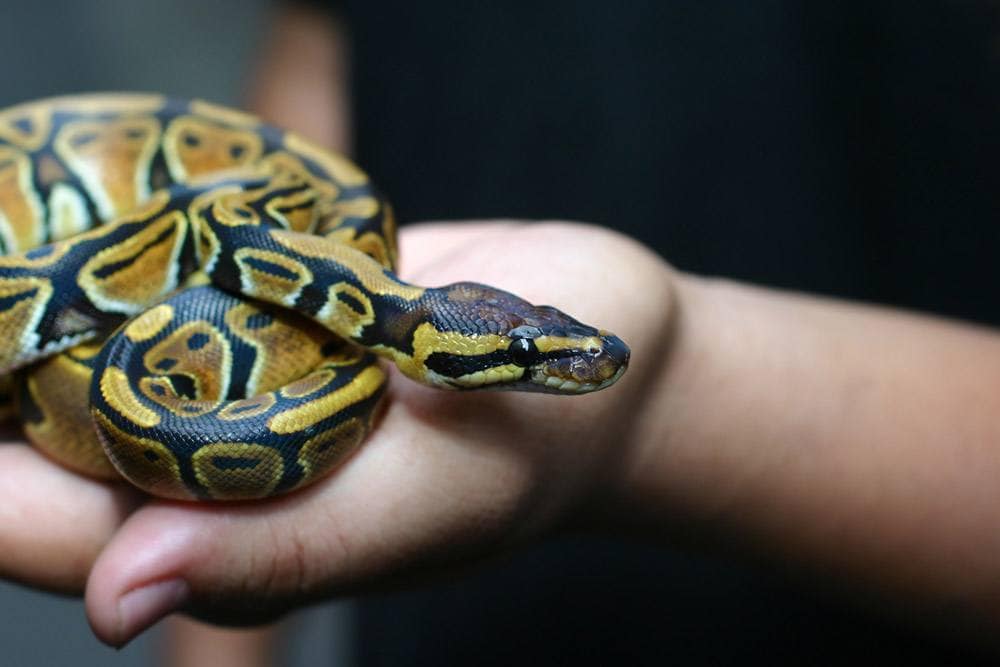

Ball pythons are one of the most popular snakes in the pet trade because of their attractive appearance, comfort with handling, and ease of care. They are known for their docile nature and they are a great starter pet for anyone interested in keeping snakes. With proper care, ball pythons make great pets that stay with you for years, but you do need to make sure you’re well educated on their care before bringing one home.

Ball Python Facts
Ball pythons are native to arid habitats and while almost all pet ball pythons were captive-bred, they all originated with breeding stock from Ghana and Toga. In the 1980s, ball pythons became extremely popular pets, which carried into the 1990s. With more reptiles entering the pet trade, they may be less popular than they were, but they are still easily one of the most popular reptiles in the trade.
These snakes can easily live for decades with proper care, with the oldest ball python on record having lived to 40 years old. Most kept as pets can live to 30 with proper care. Female ball pythons can be much larger than males, with females reaching up to 5 feet in length and males only reaching 2-3 feet. There are multiple color morphs of ball pythons and each has its own unique markings.

Are Ball Pythons Good Pets?
Ball pythons make great pets due to their gentle, docile nature and comfort with being handled. They tend to be non-aggressive and make great pets for beginning snake keepers. However, ball pythons are either nocturnal, which means they are active at night, or crepuscular, meaning they are active at dusk and dawn. This means that they prefer to sleep during the day, so it’s best to limit handling to early or late in the day.
Day to day, ball pythons don’t require much care. They should always have access to clean water in a shallow, large dish, and this water should be refreshed daily. Check the enclosure daily for waste that needs to be removed and to ensure temperature and humidity are where they should be to keep your ball python safe and healthy. Like most snakes, it is not recommended to keep them housed with any other animals, including other ball pythons.
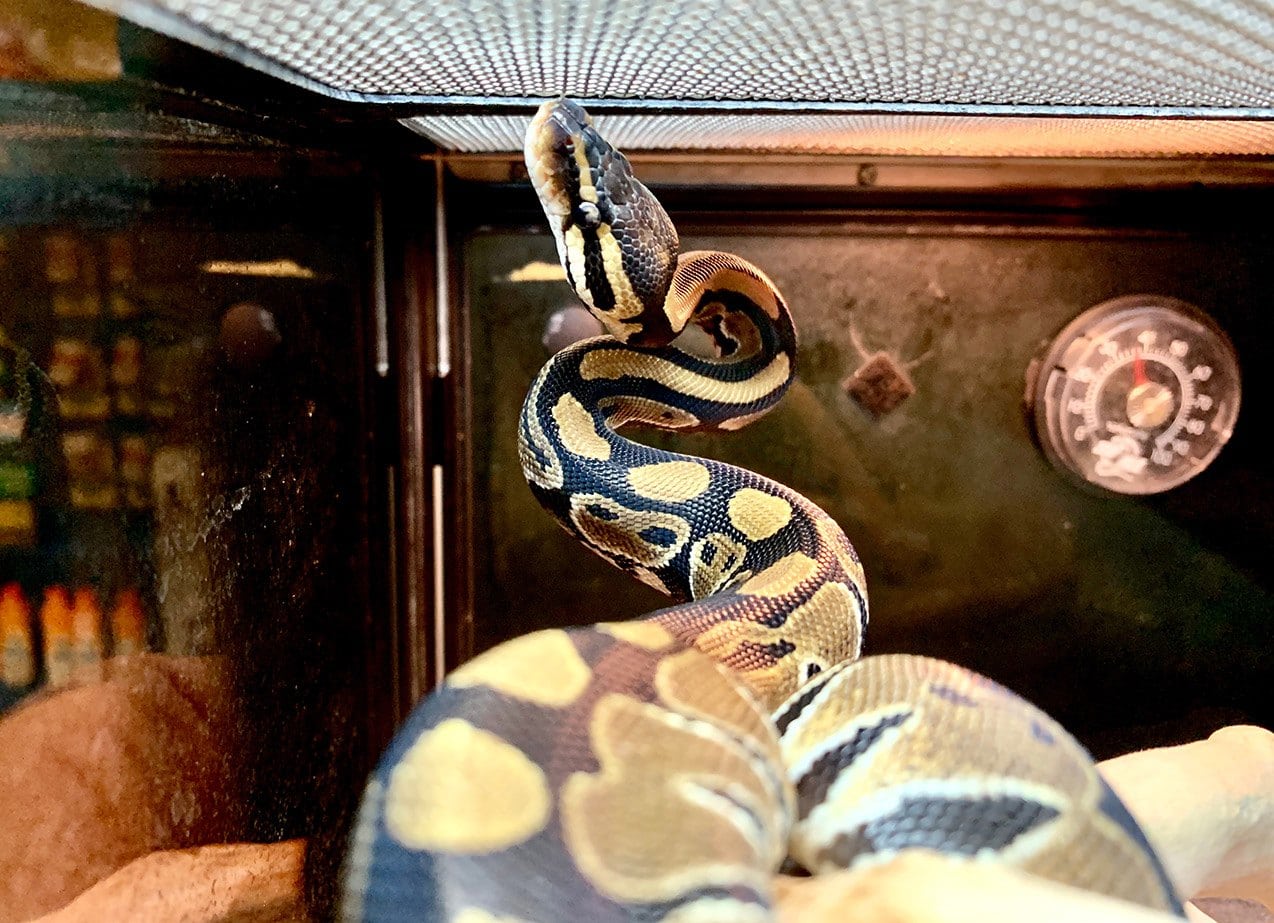
Where Can I Get a Ball Python?
Ball pythons are frequently available in big box pet stores and it isn’t unusual for them to be available in small, local pet stores. Some stores specializing in reptiles will almost always have them in stock. If you have any difficulty finding a ball python in person, they are readily available through breeders online. Read through reviews to ensure the breeder has a positive reputation for healthy snakes. You can ask for multiple pictures of the specific snake you are to receive to get an idea of their health status. Trustworthy breeders shouldn’t be unwilling to do this to ease your mind.
How Much Does It Cost To Own a Ball Python?
Expect to spend $50 or more to acquire a ball python. Most “normal” color morphs will cost you less than $100, but specialty colors can cost hundreds of dollars. You will spend, at minimum, $50 for a tank for your ball python, but this can easily increase in cost based on the enclosure you choose. That doesn’t take into account the cost of heating mats, thermometers, lights, and other necessary tank accessories, which can all add up to another $50 or more.
When you get your ball python home for the first time, it’s ideal to get them set up with a vet appointment for a health check, which will cost upwards of $65. After the initial vet visit, routine vet visits aren’t necessary, but keep an emergency fund of at least a few hundred dollars just in case. Expect to spend around $25 a month on food for your ball python and $20 or more on substrate and other tank supplies.

What Kind of Home Does My Ball Python Need?
Enclosure
It’s recommended to have a tank that is 40 gallons or larger for a ball python. If you purchase a juvenile, then you can start with a smaller tank that is around 20 gallons, but within a year you will need a larger tank. The tank should have a tight-fitting lid to prevent escapes and should be long enough that your ball python can get away from the heated area as needed.
Substrate
Reptile bark, orchid bark, crushed coconut husk, or cypress mulch are all great substrate options for ball pythons. These substrates all help retain moisture, keeping the humidity level up for your ball python. Cedar substrate is a big no-no and is toxic to ball pythons. Avoid other substrates that are excessively drying, like sand and paper.
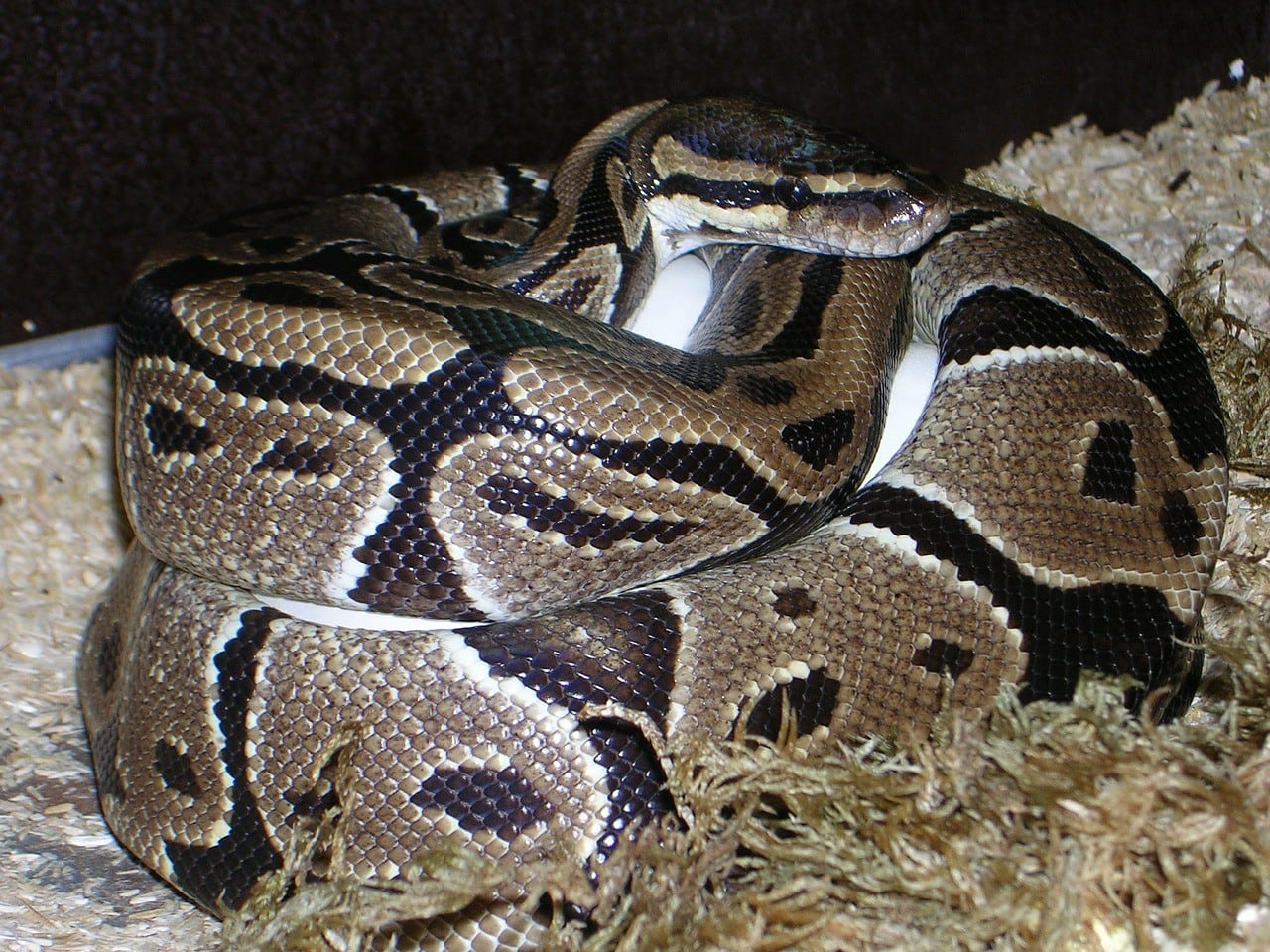
Light and Heat
UVB lighting isn’t necessary for ball pythons, so heat lamps can provide the needed lighting. They should have access to a basking area that stays around 90˚F, while the tank temperature stays between 75-85˚F, with 80˚F being ideal. Heat pads can also be used instead of heat lamps, but it may be more difficult to control the tank temperature this way. Some people prefer to keep two heat lamps for their ball python, one for daytime and another for nighttime. The nighttime lighting should be a nocturnal red light that allows your ball python to get warm without a bright light.
Accessories
Your ball python should have access to a cave or hide of some sort at both the warm and cool ends of the tank. Branches, bridges, and hills can all be provided in the tank. There are some faux and live plants that are safe for ball pythons, which can help give the enclosure a more natural look and make it more enriching for your snake. While not truly arboreal, ball pythons are semi-arboreal, which means they will enjoy having branches and smooth rocks to climb on.
Food and Water
A food bowl isn’t necessary for your ball python’s enclosure all the time but can be used at feeding time if you prefer. A shallow, large water bowl should be provided. Many ball pythons enjoy soaking in their water bowl, so it should be large enough for this without being deep enough for them to get stuck or drown.
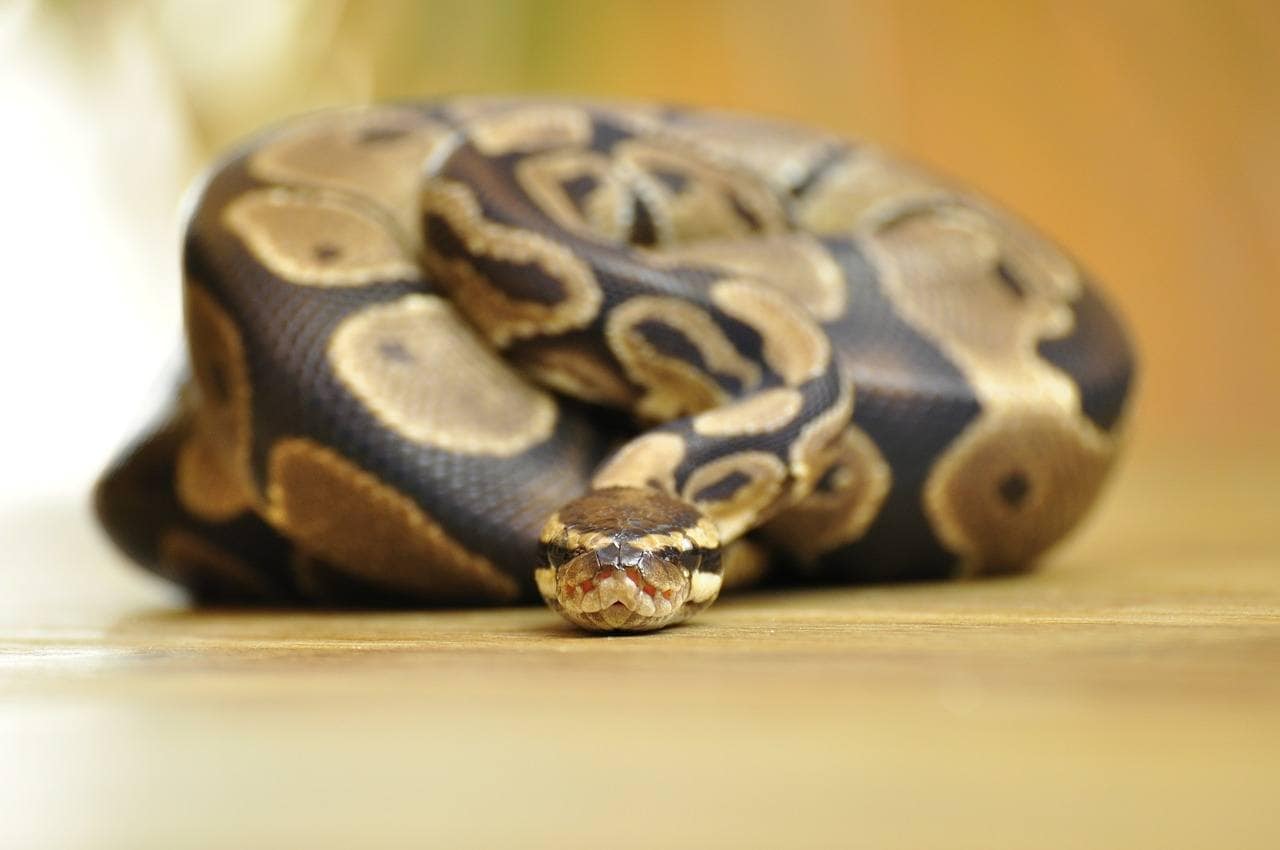
What Should I Feed My Ball Python?
Ball pythons should be fed foods that are no wider than the widest part of the snake. In young snakes, this may be insects, like crickets. In larger juvenile and adult snakes, they should be fed thawed frozen mice or rats. You may see these referred to as pinkies, which are babies that do not have fur yet, or fuzzies, which are babies with fur that have not opened their eyes yet. Young snakes may need to be fed once or twice a week, but adult snakes are unlikely to eat more often than every 10-14 days. Ball pythons can become overweight and obese, so don’t overfeed. Always keep clean water in the enclosure.
It’s extremely important to understand that you absolutely cannot feed live mice or rats to your snake. If your snake isn’t hungry, it will allow the rodent to roam its enclosure. It isn’t uncommon for rats and mice to chew on snakes, injuring them and, in some instances, killing them. As cool as it might seem to watch your ball python hunt a mouse or rat, just don’t do it.

How Do I Take Care of My Ball Python?
Feeding
Offer your ball python food that is an appropriate size for their age and size. Don’t leave uneaten food in the enclosure for more than a couple of hours, at the most. A dead mouse or rat can quickly soil the enclosure if not eaten. If your ball python doesn’t have much of an appetite, this isn’t always abnormal. If it continues, check your temperature and humidity in the tank and verify everything is working as expected. Never feed your snake live rodents.
Handling
You will need to get your ball python used to you handling it. When you first get it home, allow your snake to settle in without being handled. After a few days, begin to slowly introduce gentle touch and work your way up to your snake being comfortable being handled. Always handle carefully and if your snake doesn’t seem up to being handled, don’t force it. This will stress your snake and likely end up with you being bitten. Don’t handle your ball python after feeding as they are usually in “predator” mode and may bite you thinking your hand is food, or they will feel threatened and regurgitate their food.
Shedding
Ball pythons usually shed every 4-6 weeks, although young snakes will shed more often. They should shed their skin in one large piece, so if you notice stuck shed or difficulty shedding, a lukewarm bath can help loosen the skin. Don’t pull shed from your snake or you risk injuring them. Healthy shedding is accomplished through a healthy environment with proper temperature and humidity levels.
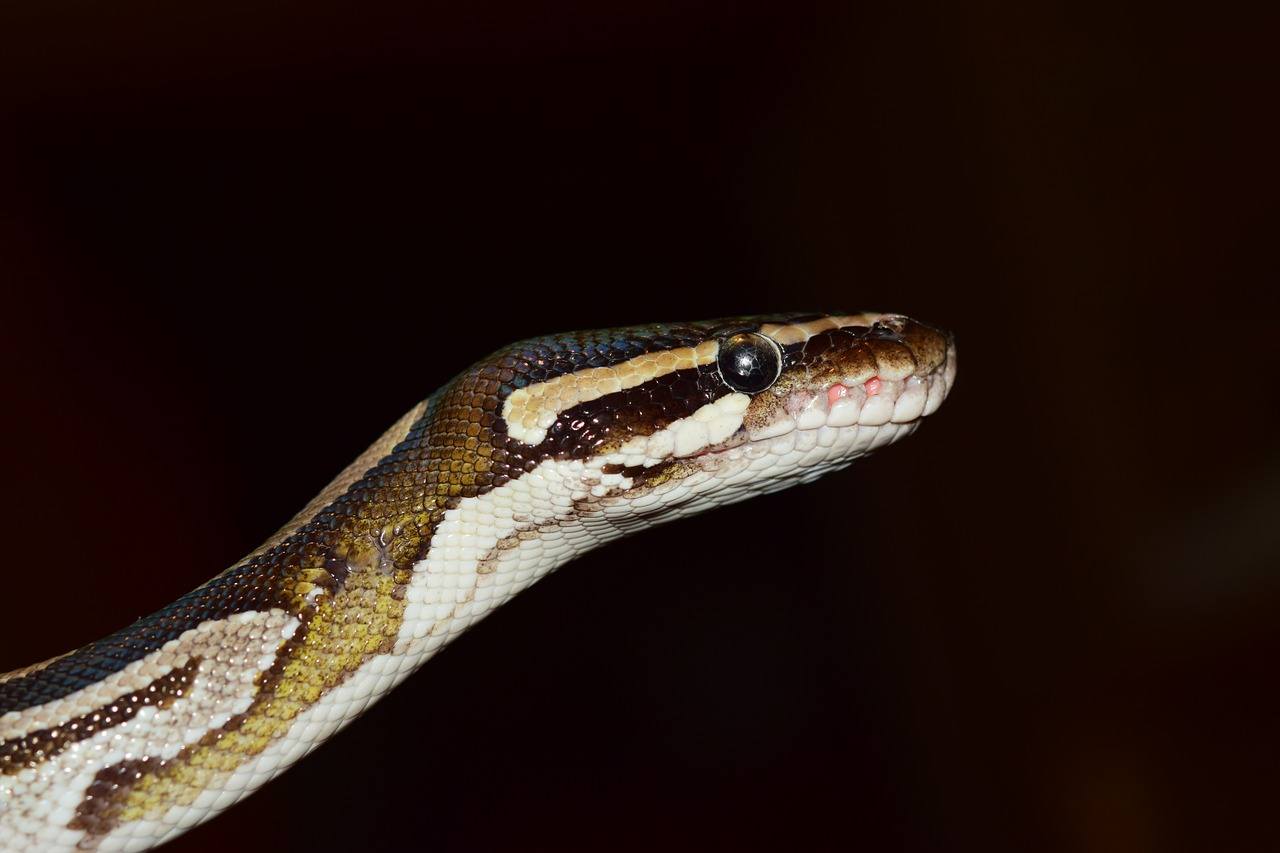
Bathing
Your ball python will likely give itself “baths” by soaking in its water dish. Otherwise, your snake does not need baths unless it is to help release stuck shed. Lukewarm baths can also help relieve constipation.
Brumation
Ball pythons do not have a brumation, torpor, or hibernation period. However, they tend to experience inappetence over the winter, so you may need to decrease the feeding frequency over this time.
Enclosure Care
Check the enclosure over daily to make sure everything is working correctly, there is no solid waste, and water is clean. The substrate should help maintain humidity levels around 60% but should be replaced if soaked or soiled. A full enclosure cleaning should be performed on a regular basis and the substrate should be replaced in full every 1-2 months.
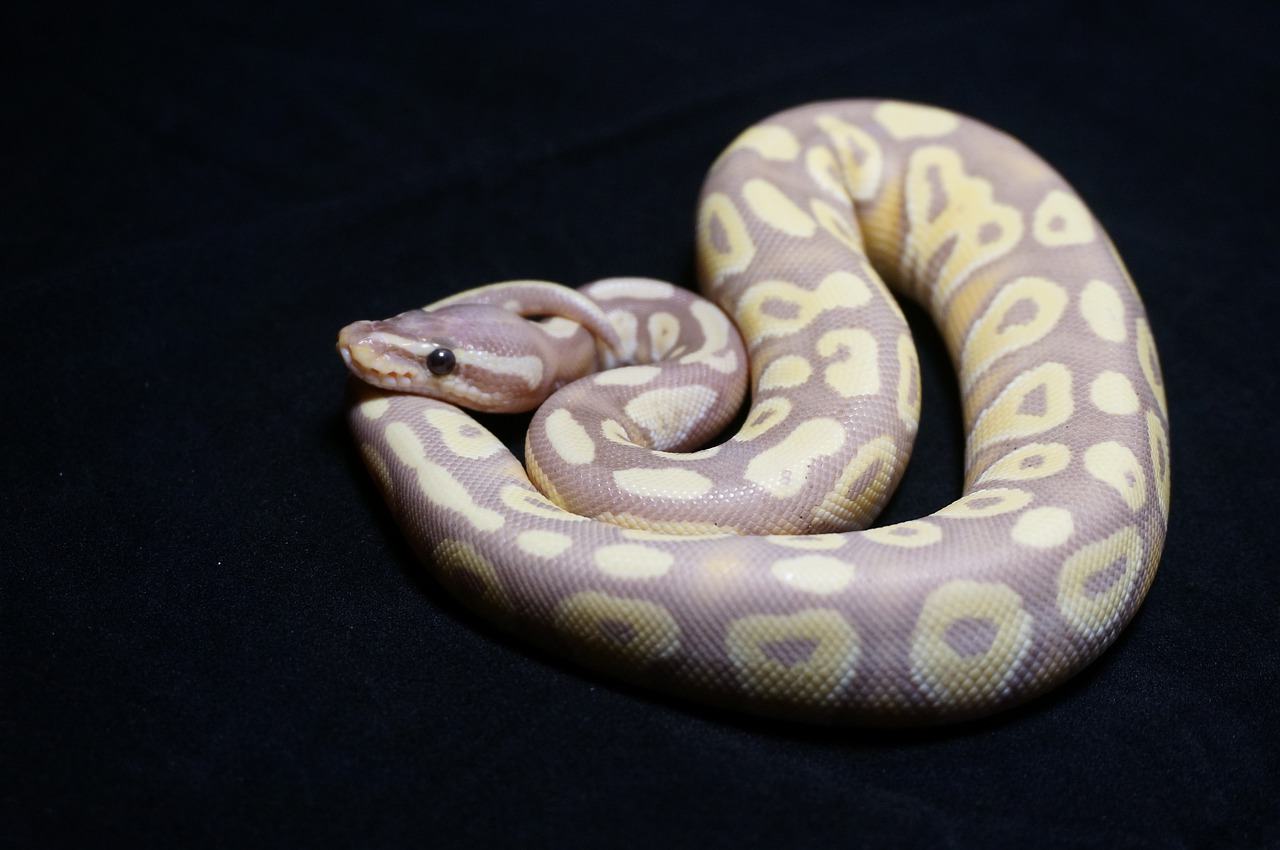
How Do I Know If My Ball Python Is Sick?
Parasites
Ball pythons can get internal parasites like hookworms, tapeworms, and pinworms, as well as external parasites like ticks and mites. Internal parasites can cause inappetence, lethargy, and visible worms in stools. External parasites may cause discomfort, anemia, and inappetence. If you suspect your ball python might have a parasite, contact your vet for treatment information.
Respiratory Infections
Respiratory infections can be caused by viruses and bacteria and are often caused by poor enclosure conditions and humidity levels that are too high. If your snake seems lethargic or you notice changes in breathing, increased work of breathing, or any wheezing or breathing sounds, your snake should see a vet as soon as possible as respiratory infections can be deadly.

Inclusion Body Disease
This fatal disease is recognizable by the neurological symptoms it causes, including a head tremor, pupils that are different sizes, muscle contractions that cause the head to look upward (“stargazing”), muscle wasting, lethargy, abnormal or confused behavior, and an inability to correct the body position. Inclusion Body Disease is contagious and often has other serious secondary infections associated with it. If your snake has these symptoms, they should see a vet immediately but the prognosis for treating this disease is very poor.
Scale Rot
Scale rot is an infection of the skin under the scales caused by contact with bacteria in poor conditions, specifically, direct contact with soiled substrate. This disease is recognizable by pus or fluid-filled blisters on the skin, skin discoloration, and raised scales. If you see these symptoms, your snake should see a vet and you should evaluate the enclosure for sources of infection.

Conclusion
Keeping a ball python can be fun, but it is a long-term commitment to proper care. Without proper care, your snake will become sick and will have a significantly shortened life expectancy. Considerations of the necessary aspects of the enclosure and feeding needs should be taken into account when considering a ball python for your home. If provided adequate care, your ball python will likely become comfortable with you and enjoy being handled.
Featured Image Credit: Krisda Ponchaipulltawee, Shutterstock
Brooke Billingsley spent nine years as a veterinary assistant before becoming a human nurse in 2013. She resides in Arkansas with her boyfriend of five years. She loves all animals and currently shares a home with three dogs, two cats, five fish, and two snails. She has a soft spot for special needs animals and has a three-legged senior dog and an internet famous cat with acromegaly and cerebellar hypoplasia. Fish keeping has become a hobby of Brooke’s and she is continually learning how to give her aquarium pets the best life possible. Brooke enjoys plants and gardening and keeps a vegetable garden during the summer months. She stays active with yoga and obtained her 200-hour yoga teacher certification in 2020. She hosts a podcast focusing on folklore and myth and loves spending her free time researching and writing. Brooke believes that every day is an opportunity for learning and growth and she spends time daily working toward new skills and knowledge.




![WordPress Coupon Code 2024 [64% OFF Code ????] Live](https://bloggerspassion.com/wp-content/uploads/2024/04/wordpress-coupon-code.jpg)

